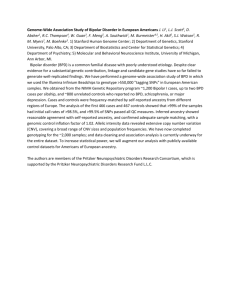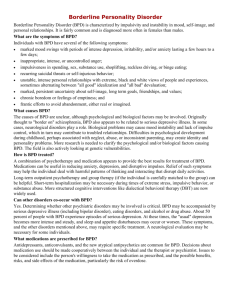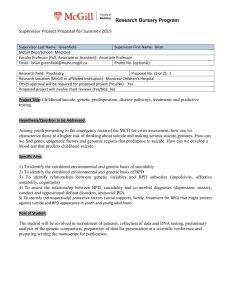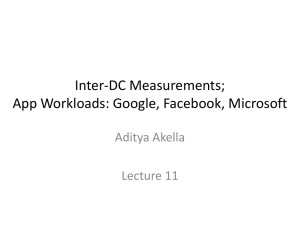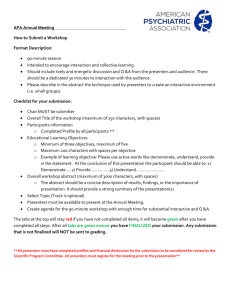Intel Presentation Template Overview
advertisement
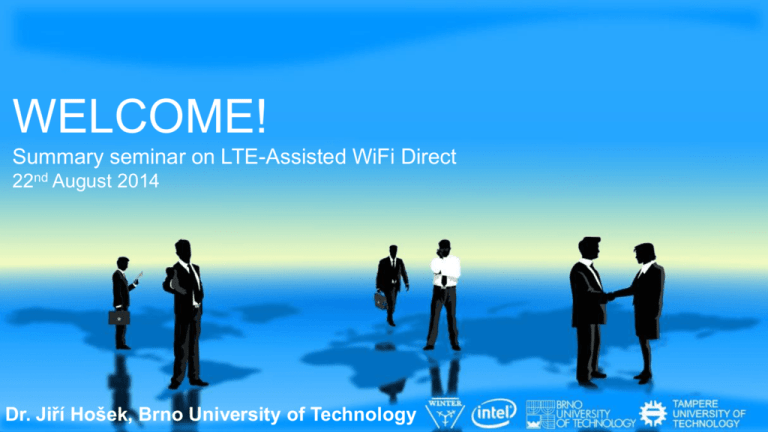
WELCOME! Summary seminar on LTE-Assisted WiFi Direct 22nd August 2014 Dr. Jiří Hošek, Brno University of Technology Introduction Brno, Czech Republic •Brno University of Technology •Faculty of Electrical Engineering and Communication •Department of Telecommunications Unique R&D fellowship •INTEL Labs, US •Tampere University of Technology (TUT), Finland •Brno University of Technology (BUT), Czech Republic Agile, time-critical and industrially-oriented research •5G technologies and services •Internet of everything •Improved user experience Agenda 3 14:00 – 14:10 Welcome, introduction, and agenda of the seminar 14:10 – 14:20 Network-assisted D2D technology: project overview and our mission 14:20 – 14:30 An update on Proximity Services (ProSe) in 3GPP standardization 14:30 – 14:40 Technical capabilities of a unique 3GPP LTE-A deployment in Brno 14:40 – 15:00 On technical implementation of the LTEAssisted WiFi Direct trial 15:00 – 15:15 Showcasing network-assisted D2D technology: demonstration & questions 15:15 – 15:30 Practical benefits of LTE-assisted WiFi Direct and associated challenges 15:30 – 15:45 Novel D2D-based service & application opportunities and market enablers 15:45 – 16:00 Summary of the seminar, conclusions, and feedback 19:00 Social event: dinner at Havana restaurant Network-assisted D2D technology Project overview and our mission Dr. Sergey Andreev: W.I.N.T.E.R. Group, TUT Network Assistance at a Glance Applications of proximate connectivity • Local voice service (offloading calls between proximate users) • Context-aware applications Unprecedented operator and end • Multimedia content sharing user benefits by enabling a new • Group multicast generation of proximity services • Public safety Automated, continuous, and • Gaming efficient assistance with secure discovery of devices & services Improved device-to-device (D2D) connection establishment, battery efficiency, and service continuity Our Integrated Approach to Studying D2D Network is accurately modeled with our advanced SLS tool 3GPP LTE may assist its clients in content/service discovery as well as in connection establishment • Client searches for the desired content/services • Network tells it when a suitable peer is in proximity 6 Understanding D2D Performance Limits We investigate LTE-assisted WiFi D2D offloading • System-level simulations and analysis • Performance requirements and benefits • Advanced network-assistance features • 3GPP LTE-assisted WiFi-Direct demo Considerable quality of service improvement for mobile clients (e.g., session acceptance probability) Significant boost in cell throughput 7 Network-Assisted Offloading Architecture This 3GPP-compliant technology builds on our rigorous research, MWC-2014 demo, and is ratified in 3GPP LTE Release-12 Devices receive help from the network during device discovery and D2D connection establishment Secure D2D connectivity between stranger users! 8 The Mission of “The Brno Trial” We have completed a full-scale trial to understand the practical benefits of assisted WiFi-Direct technology and discuss market opportunities that it offers… Does LTE-Assisted WiFi Direct has the potential to offload licensed bands and enrich applications and services in current mobile ecosystem? In this seminar, we encourage partners to discuss the future opportunities offered by proximity-based services and to find the way to go forward! 1. S. Andreev, et al., Cellular Traffic Offloading onto Network-Assisted Device-to-Device Connections, IEEE Communications Magazine, April, 2014 2. S. Andreev, et al., Analyzing Assisted Offloading of Cellular User Sessions onto D2D Links in Unlicensed Bands, IEEE Journal on Selected Areas in Communications, September, 2014 3. A. Pyattaev, et al., Network-Assisted D2D Over WiFi Direct, in Smart Device to Smart Device Communication, Springer, 2014 4. A. Pyattaev, et al., Network-Assisted D2D Communications: Implementing a Technology Prototype for Cellular Traffic Offloading, IEEE WCNC, 2014 5. A. Pyattaev, et al., Proximity-Based Data Offloading via Network Assisted Device-to-Device Communications, IEEE VTC-Spring, 2013 6. A. Pyattaev, et al., 3GPP LTE Traffic Offloading onto WiFi Direct, IEEE WCNC, 2013 9 LTE-Assisted WiFi Direct trial Experimental communication system at Brno University of Technology Assoc. Prof. Vít Novotný, BUT History of System • • In 2008 Sensor, Information and Communication Systems (SIX) project was started at FEEC BUT (15 mil USD budget) – the main goal was to equip laboratories for high level research S5/S8 S-GW S7 PDN-GW PCRF/PDF S1-U Rx/Gq S11 S1-MME eNodeB X2 S1-U the SIX Research Center was established in 2010, S1-MME P-CSCF Rx S2/SGi Mw MME I-CSCF S6a Cx Mw Cx • in 2012 the manager and the development plan of the Laboratory of Converged Network technologies was relooked and the idea of complex wireless communication system was proposed, eNodeB HSS/Auc Sh AS S-CSCF Internet Mm ISC • change plan was worked out, application was passed and approved by MSMT of CR, • tender was worked out – three proposals offering two technologies (Huawei and Ericsson) were received – Huawei solution was selected, • system deployment began in August 2013, • system is in the phase of almost full operation with a correction of minor problems Mw Mission The main objectives: • Ownership of unique, latest and complex communication system – unified mobile, wireless and fixed telecommunication network infrastructure that would enable: • getting valuable experience from working with the latest technology, • having full control of the system, • learn how to troubleshoot problems in a complex telecommunication network. • Research in the area of: • design, testing and analysis of new communication protocols, • design, testing and analysis of new communication services, • communication system planning and performance optimization. Mission – cont. • Establishment of cooperation with other research organizations and with industry • new service and equipment testing in our experimental network, • interfacing with other telecommunication systems and solutions, • public network performance assessment – KPI design, measurement and calculation, evaluation, • public network diagnostics, troubleshooting and optimization, • development of new telecommunication services, etc. VUT Brno Separate address space WiFi-IP4 LTE/WiFi-EPC-IMS (Huawei solution) LTE WiFi C IP 700 MHz LTE 700 MHz 1800 MHz LTE RRU RRU 2600 MHz BBU RRU BBU IMS (CSCFs + RCS) SeGW X2 Access transport network MME Separate address space CN-IP2 HSS Core transport network BBU 700 MHz RRU Overall architecture of LTE/WiFi – EPC – IMS experimental network at Brno University of Technology Home eNB Separate address space RAN-IP1 RRU LTE Separate address space – IMS-IP5 700 MHz BBU Separate UE e address spac UE-IP3 S/P-GW O&M Application servers L3 Switch Internet Public address space - VUT 147.229.x.y Router / VPN / NAT LTE Cell Map WiFi Cell Map Complementary Equipment • Rohde & Schwarz ROMES4 traffic analyzer + TMSW spectrum analyzer, • EXFO Powerhawk Pro + TravelHawk + M5 protocol analyzer, User Plane Deep Packet Inspection, • L2 - L7 load generators for performance & stress testing, • Set of multi-technology and multi-band terminals – smart phones, notebooks, tablets and USB sticks for all generations of mobile networks. LTE/WiFi-EPC-IMS Technical capabilities of a unique 3GPP LTE-A deployment in Brno Assoc. Prof. Vít Novotný, BUT Huawei Architecture Service O&M CTAS RCSe Server (MMTel AS/SCC AS/IP-SM-GW/EATF) RCSe ATS9900 IMS Core Provisioning GW SPG2800 ENUM /DNS ENS I/SCSCF/MRFC/ECSCF CSC3300 MRFP MRP6600 SBC (P-CSCF/A-SBC/I-SBC SE2600 IMS-HSS HSS9820 EPC MME IP Network S/P-GW LTE eNB LTE data-card + soft client eNB LTE Handset (immature) PC Client SIP Phone eUTRAN Heterogeneous Radio Access Network: • LTE Advanced (Release 10) cells • 3x 700 MHz (Band 17 – AT&T) 5 MHz FDD, 2x2 MIMO • 1x 1800 MHz – Outdoor coverage • 1x 2600 MHz – Indoor unit, 2x2 MIMO • WiFi: • 3 APs in 2.4 GHz and 5 GHz ISM bands eNodeB BaseBand Unit eNodeB – Remote Radio Units Evolved Packet Core • Unified Gateway (UGW) includes: • PDN GW, • Serving GW, • MME, • HSS, • Fully redundant 10 Gbps links, • Interface mirroring for probe based analysis. IP Multimedia Subsystem • Release 10, Service O&M CTAS RCSe Server (MMTel AS/SCC AS/IP-SM-GW/EATF) RCSe ATS9900 • IMS core + RCS, • 100k active users, • Enables VoLTE, IMS Core Provisioning GW SPG2800 • Public Safety Answering Point, • Additional HSS, ENUM /DNS ENS IMS-HSS HSS9820 • Full redundancy. I/SCSCF/MRFC/ECSCF CSC3300 MRFP MRP6600 SBC (P-CSCF/A-SBC/I-SBC SE2600 EPC MME S/P-GW IP Network Installation Process LTE/WiFi – EPC – IMS experimental network at Brno University of Technology Technology Installation Technology Installation – cont. SGi – internet interface, EXFO analyzer and test servers for network performance evaluation Implementation details Network-assisted offloading to WiFi Direct Dr. Alexander Pyattaev, TUT Mikhail Gerasimenko, TUT Introduction to Our 5G Vision • “True” 5G vision: • Optimal resource usage on all levels • 1000x capacity • Application and QoS-aware link planning • Multi-RAT capabilities: • Most suitable radio for each link • Seamless integration of WLAN and cellular • Multi-tier capabilities: • Increased capacity of 3GPP networks • Phantom cell concepts • COMP, eICIC…. HetNet: Current Status • ANDSF function: • UE decisions are always suboptimal • TCP flow switching is very tricky • Does not happen properly with mobile IP • Usage of multiple paths is not supported • Only works with multipath TCP • UEs typically lack software • Servers lack software • Hard to enable multiple radios in UEs • Phantom cells are still just a concept • Femtocells are expected to “just work” • Interference cancellation is very difficult Flow Manipulation for RAN-Assisted 5G HetNets • Do we need a circuit-switched network? • Where each service/application uses its own personal circuit (flow)… • …and each circuit is routed independently… • …keeping the packet in order, and jitter low? • Application-coordinated flow switching • Context-based and location-based • Working QoS support • RAN-assisted flow control • Simplified access through non-3GPP networks • Dynamic switching in real-time Flow Switching Architecture Example • Open-Flow based “layer 2.9” switching implements a working integrated cell • One IP for both RATs • Instant, network-controlled switching • Load balancing between RATs • Prototype created and tested in TUT on Sailfish platform • The final prototype implies integration with real EPC and a real femtocell D2D offload – a Subcase of Flow Switching • D2D is just like HetNet • A flow from A to B via C is switched to A - B • That sounds easy enough... • In practice, D2D faces 3 challenges: • Lack of application support (even for P2P) • Aggressive firewalling in operator networks • Lack of efficient discovery mechanisms • Application-coordinated flow switching is necessary • QoS support • Smart RAT selection • Same as for HetNets! D2D Flow Switching in Plain IP • Set up the D2D radio link • e.g., over WiFi Direct • Enable IP forwarding in the UE • Make a virtual loopback interface (like in routers) • Make the applications bind to that interface • Add a route to the target virtual interface over WiFi • This switches the flow between 2 devices to D2D link • The Internet connectivity is unaffected • Remove the route when D2D link is about to break • This reverts connection to cellular IP flow Switching Details Deployment in Brno University of Technology Practical benefits of LTE-assisted WiFi Direct and associated challenges Aleksandr Ometov, TUT Konstantin Zhidanov, invited expert Lessons Learned: • LTE positioning support • OTDOA/AoA based • IMS support • Required to deploy the D2D server • Reconfigured firewall between UEs • For P2P communication over LTE • “Cooperative” UE platform and application • Operator Deployed package • That could be an issue, especially for closed platforms; relatively easy on Linux-based phones Faced Development Challenges • Positioning • Triangulation • Cell-based • Signal strength • etc.. • IPC data integration Proposed Technologies Classification • Implementation highlights: • One-hop: • Offloading onto unlicensed bands • Spectrum reuse • Multi-hop: • Range extension • Group multicast Offloading onto Unlicensed Band • Proximity based offloading: • Low end-to-end delay • Controlled switching • Forced usage • Local Voice Service • Challenges: • Positioning Cell Range Extension • Range extension: • Relay • Link through the trusted user • Service continuity • Challenges: • Trust • Privacy • Incentive schemes (“friendly” peers) WiFi Direct Group Usage • Local content redistribution • Group multicast • Faster content access and distribution • Challenges: • Sharing policies • Key redistribution Market and trends overview Novel D2D-based service & application opportunities and market enablers Olga Galinina, TUT Alexey Koren, invited expert Agenda Mobile trends overview: insights into the market Proximity D2D services concept D2D services use cases and applications Further step: proximity D2D platform Overall Mobile Market Global mobile market will continue to grow steadily in the next few years Source: INTERNET TRENDS 2014 – CODE CONFERENCE. Mary Meeker, May 28, 2014, Kleiner Perkins Caufield & Byers (KPCB) Location Based Services LBS Adoption 62% Heard of 30% Familiar Berg Insight: mobile location platforms revenues will grow to € 275 million worldwide in 2018 • 6 in 10 are aware of LBS • People who use LBS find them valuable • Young people lead LBS adoption 24% Used TechNavio’s: Global Indoor LBS market to grow at a CAGR of 40% in 2016 Source: Location Based Services Usage & Perceptions Survey. Cross-Tab Marketing Services &Telecommunications Research Group for Microsoft Corporation Massive Content Generation Uploadable / Findable / Shareable / Real-Time Data Rising Rapidly Source: INTERNET TRENDS 2014 – CODE CONFERENCE. Mary Meeker, May 28, 2014, Kleiner Perkins Caufield & Byers (KPCB) 1 zettabyte = 1 trillion gigabytes Source: IDC report “Extracting Value from Chaos” 6/11 “Amount of global digital information created & shared – from documents to pictures to tweets – grew 9x in 5 years to nearly 2 zettabytes* per IDC”. Changes in Content Distribution Patterns Source: Anjney Midha, KPCB Associate; Jared Morgenstern, KPCB Entrepreneur Partner Mobile Advertisement Location-based advertisement (LBA) 2015: • total revenues $6.2 billion • 35% of total mobile advertising revenue Source: Pyramid Research Re-imagining Conventional Mobile Services Proximal D2D Services Paradigm • Key feature supported by the next generation cellular networks • Enables mobile devices to discover presence of others in proximity to communicate directly • Direct connectivity (minimal network involvement ) • Free of charge, fast and energy efficient transmission • Ambient awareness (“wireless sense”) • Local resource discovery (ad-hoc/network-assisted) • Service continuity and automation • Privacy (no 3rd party involvement) Offers new business opportunities • for mobile stakeholders Opportunities for highly relevant advertisement SWOT Analysis • • • • • • WEAKNESSES Server side needed Integration on operators and mobile OS vendors side required Challenging security policies THREATS Operators and mobile OS vendors may be slow to adopt integration Developers may have difficulty adopting the architecture Some people are concerned about disclosing their locations Although the market is small today, adoption will soon take off! D2D Services Use Cases and Applications (selected large markets) D2D Use Case: Gaming • Alice likes to play Japanese Mahjong but it takes 4 people for a game • She marks herself as “available for game” and notification automatically appears when 3 more guys with the same status gather in proximity • If the match is agreed upon – ad-hoc network is set up for multiplayer game PriceWaterhouseCoopers: the global wireless games market reaches $14.4B by 2017 D2D Use Case: Social Services • People who visit same places with you are more interesting persons to you as they share your lifestyle • And you really do not want somebody to keep track of and analyze your dating activity log • 11% of adult Americans ever tried digital dating (Pew Research Center) D2D Use Case: Advertisement • Art media content in shopping malls • Music feed near jazz cafe • Check in for 5 shops and get a free donut D2D Use Case: Public Safety • P2P communications (incl. outside network coverage) • Automated D2D discovery helps to find people in danger and may be used to navigate to one’s phone • Multi-hop coverage extension helps rescue team to get coordination from base and transmit video from incident place D2D Use Case: Serendipity as a Service • Alice is fond of board games and her profile somehow knows about it • When visiting Brno she is walking near the building where hidden local board game club is located • Alice gets a notification and is able to jump in and have a very nice and unexpected evening • Same with shops, people, and services D2D Use Case: Everything You Can Imagine • Delayed content download • Secure content transmission • Proximity-based “I’m feeling lucky” D2D Proximity Service Platform Important features: ▪ Provide ambient awareness ▪ Track proximity ▪ Push notifications ▪ Initiate connections Further steps: Develop software and API architecture ▪ Ad-hoc network coordination Make a demo in the testbed Make a pilot within the real network Formulate technology integration plan Conclusion • The wireless service industry is a competitive and fast moving • D2D concept strengths clearly outweigh its weaknesses in several ways • D2D properly deals with possible threats and expands to new opportunities Experience Perception Adoption
